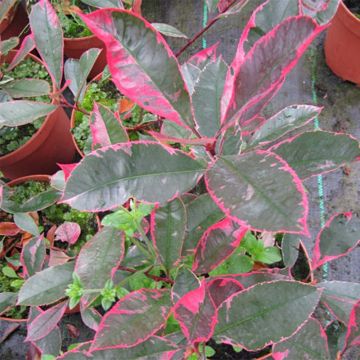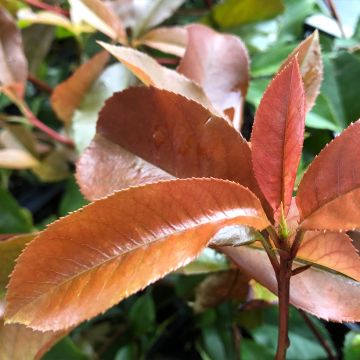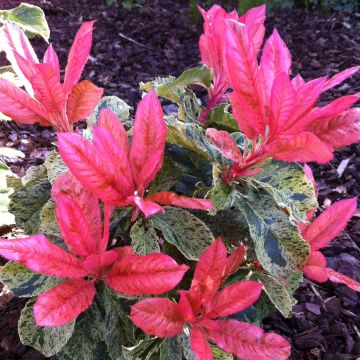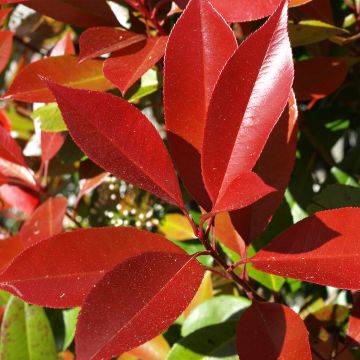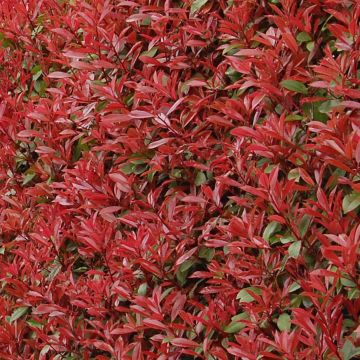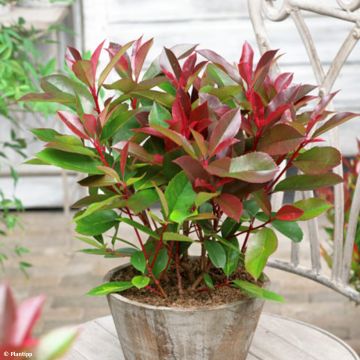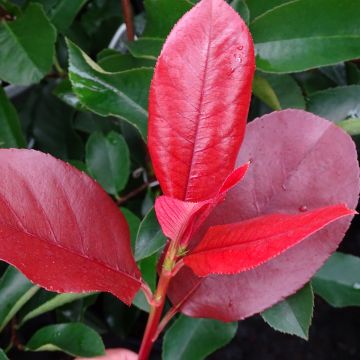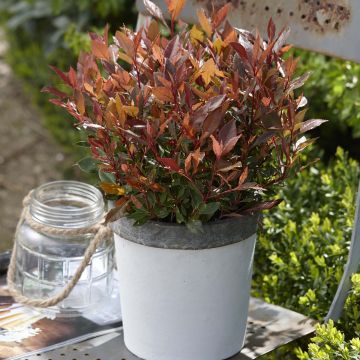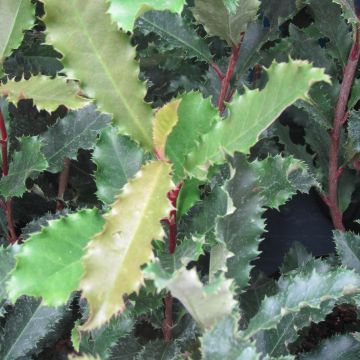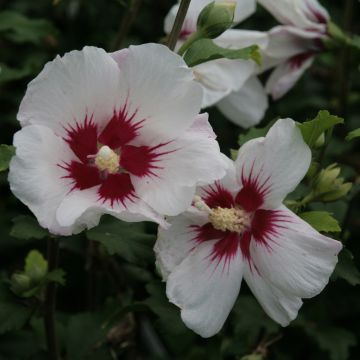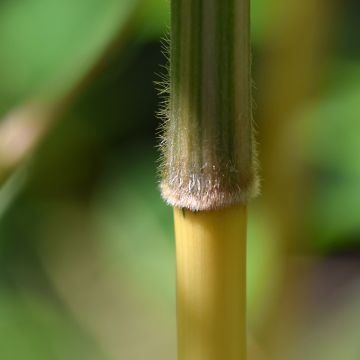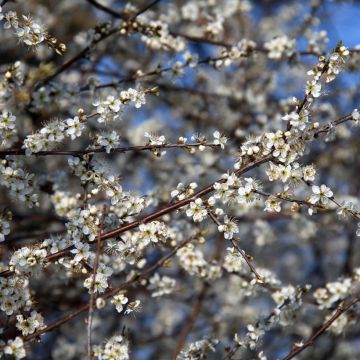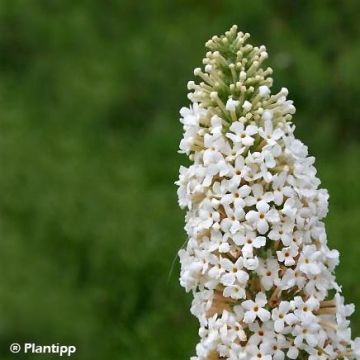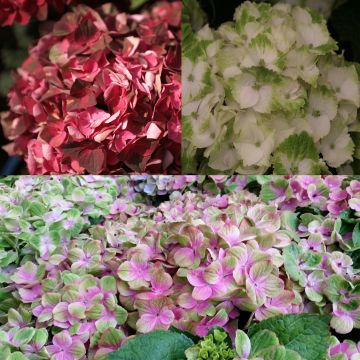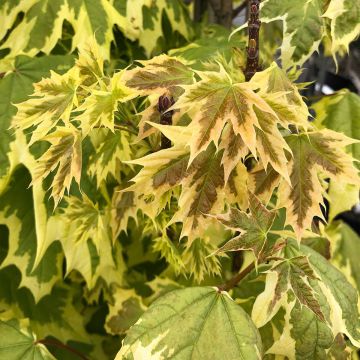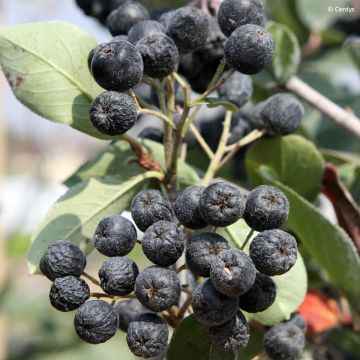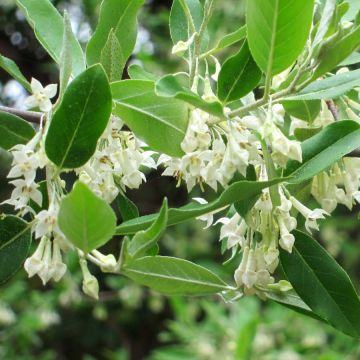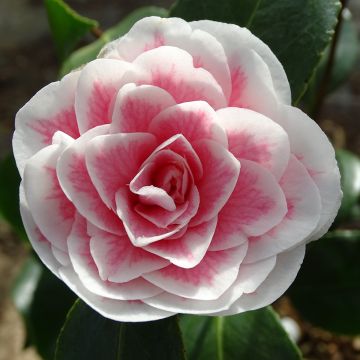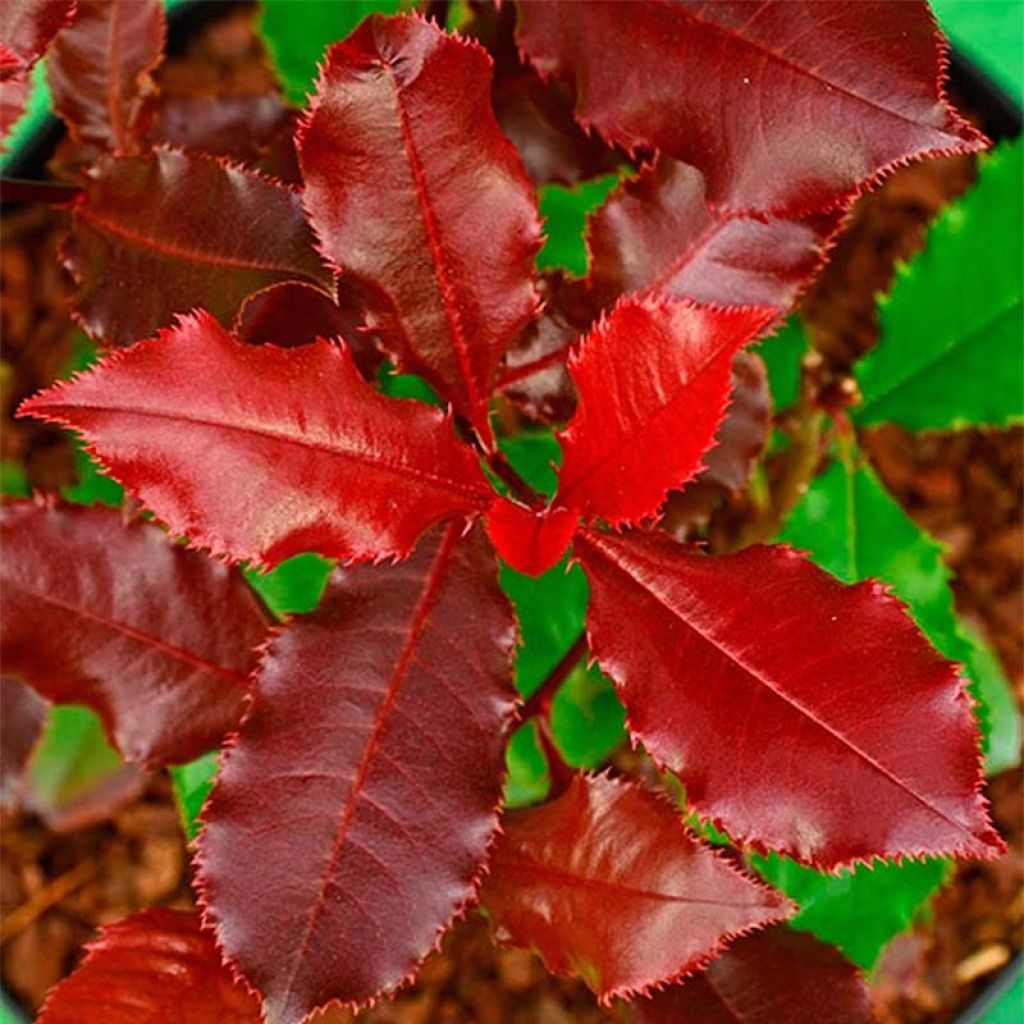

Photinia fraseri Magical Volcano - Christmas Berry
Photinia fraseri Magical Volcano - Christmas Berry
Photinia x fraseri Magical Volcano® ('Kolmavoca')
Christmas Berry, Redtip Photinia
Plant well taken, impeccable condition.
JF, 12/10/2024
This item cannot be shipped to the selected country
Delivery charge from €5.90
Delivery charge from €5.90
More information
Schedule delivery date,
and select date in basket
This plant carries a 24 months recovery warranty
More information
We guarantee the quality of our plants for a full growing cycle, and will replace at our expense any plant that fails to recover under normal climatic and planting conditions.
From €5.90 for pickup delivery and €6.90 for home delivery
Express home delivery from €8.90.
From €5.90 for pickup delivery and €6.90 for home delivery
Express home delivery from €8.90.

Does this plant fit my garden?
Set up your Plantfit profile →
Description
The Photinia fraseri 'Magical Volcano' 'Kolmavoca' is a new selection of photinia that is remarkable throughout the year for its young foliage, which is remarkably coloured in shades of red to purple. From January to December, they light up its older foliage, which is a bright and shiny green, with small flames that retain their vibrant colours for a long time. And like all photinias, when left untrimmed, it produces clusters of white and frothy flowers in late spring, which contrast with the young shoots and the older foliage on a beautiful multicolored bush. Comfortable in any good garden soil, including coastal areas, this new Photinia easily adapts to areas that are not too cold in winter.
The Photinia x fraseri or Fraser Photinia is an old horticultural creation born in 1940 in the USA. This hybrid is the result of cross-breeding between the Photinia glabra, native to Japan, and the Photinia serrulata, native to China. It has given birth to some famous cultivars, including 'Red Robin', which is widely planted in our parks and gardens. In recent years, some beautiful new cultivars have been created, more compact, more colourful and better suited to small spaces, such as 'Magical Volcano'.
Reaching an average of 2m (6 ft 7 in) in height and 1.50m (4 ft 11 in) in spread, the Photinia 'Magical Volcano' has a rather upright bushy habit, and shows a fast growth. Its foliage is evergreen in winter, composed of leaves arranged alternately on the branches. They are tough and glossy on the top, about 5-7cm (2-2.8 in) long, finely and strongly toothed on the edges, slightly undulating. When they emerge, they have a superb red colour that slowly changes to purple-violet, then bronze, and finally to a bright green when mature, at around one year old. In many other varieties, this transition from red to green takes only a few weeks in spring, so that the foliage is uniformly green in summer and winter if the bush is not regularly pruned. Flowering takes place from April to June depending on the climate and region. Clusters of small white flowers appear on the reddish branches, reaching 10cm (3.9 in) in diameter, mainly at the ends of the branches. They are slightly fragrant and attract many pollinating insects.
In addition to the beautiful colouring of its young foliage, its hardiness and adaptability to all soil types have earned the Photinia x fraseri worldwide success. 'Magical Volcano' can tolerate all types of well-drained soil, from deep and moist to dry, in sunny or semi-shaded locations. It is an easy-to-grow and easy-to-maintain bush that can withstand temperatures down to -15°C if exposed to the sun. Of course, it is ideal for creating medium-sized hedges, trimmed or untrimmed, and it adapts to container cultivation and looks magnificent in borders. Very ornamental, it can also be planted as a specimen in a small garden. There are many possible combinations depending on the region and the taste of each gardener: with other evergreen shrubs that are easy to grow, such as Elaeagnus ebbingei Compacta, laurels, Rhamnus alaternus Argenteovariegata, Berberis, Olearia, holly, or Osmanthus. It can also be paired with other white-flowering shrubs in spring, such as Spireas (Spiraea Vanhouttei, Spiraea Grefsheim...) or Lilac.
Tips: Excessively chalky or too clayey and compact soils should be avoided. Pruning for balance is necessary in summer.
Report an error about the product description
Photinia fraseri Magical Volcano - Christmas Berry in pictures
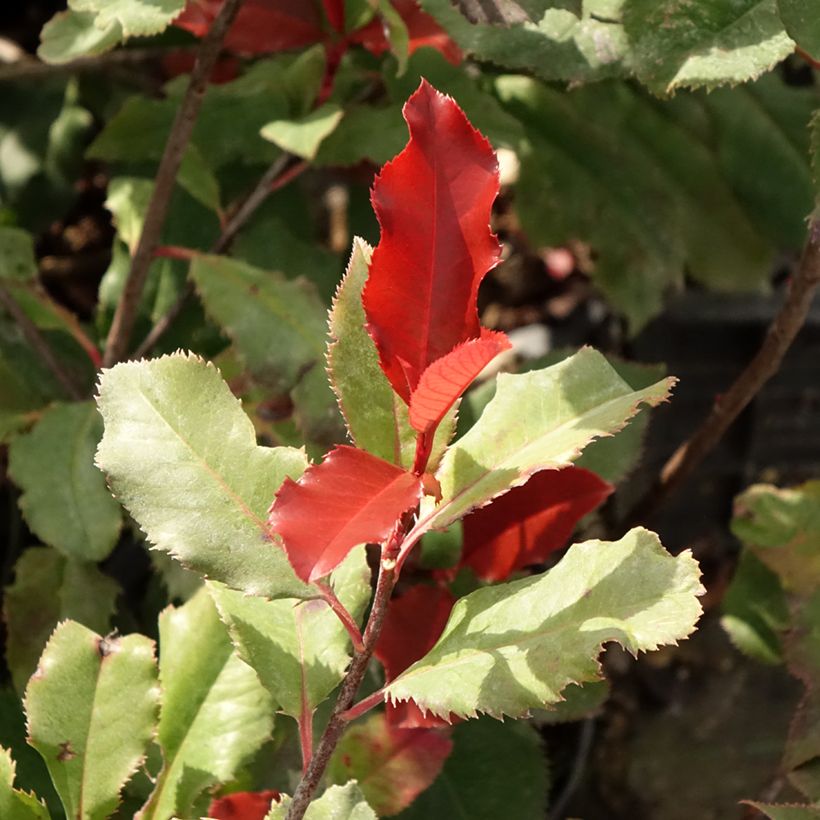

Plant habit
Flowering
Foliage
Botanical data
Photinia
x fraseri
Magical Volcano® ('Kolmavoca')
Rosaceae
Christmas Berry, Redtip Photinia
Cultivar or hybrid
Other Photinias
Planting and care
The Photinia fraseri 'Magical Volcano' should be planted in spring or autumn in any deep, moist to dry soil in summer, fertile and well-drained, not too clayey and heavy. Once well established, it tolerates summer drought if it has deep soil. It prefers a sunny or semi-shaded exposure, sheltered from cold and gusty winds. It also tolerates shady exposures, at the expense of flowering and the intensity of the colouration of young foliage. Compost should be added at planting. Water well for the first two years, once or twice a week, especially in hot and dry weather. Mulch the soil to keep it cool in summer in hot regions and protect the base in winter in very cold regions. Prune in summer to balance the habit, cutting back half of the branches. This will promote the regrowth of young, highly coloured leaves in autumn. Note that climates with mild, humid and cool seasons promote the growth of photinias and the renewal of red young shoots, which can then be produced throughout the year. Pay attention to the pruning period if you want to have flowering.
The Photinia is generally a robust plant with few enemies. However:
In humid weather or, conversely, in certain very dry and poor soils, photinias can be affected by a fungus (entomosporiosis). Watch the leaves, if black and red spots appear, treat with Bordeaux mixture. The otiorhynchus beetle can also nibble the edges of the leaves at night, while their larvae can attack the roots: treat the soil with nematodes that parasitize the larvae (in fresh soil).
Planting period
Intended location
Care
-
, onOrder confirmed
Reply from on Promesse de fleurs
Hedge shrubs
Haven't found what you were looking for?
Hardiness is the lowest winter temperature a plant can endure without suffering serious damage or even dying. However, hardiness is affected by location (a sheltered area, such as a patio), protection (winter cover) and soil type (hardiness is improved by well-drained soil).

Photo Sharing Terms & Conditions
In order to encourage gardeners to interact and share their experiences, Promesse de fleurs offers various media enabling content to be uploaded onto its Site - in particular via the ‘Photo sharing’ module.
The User agrees to refrain from:
- Posting any content that is illegal, prejudicial, insulting, racist, inciteful to hatred, revisionist, contrary to public decency, that infringes on privacy or on the privacy rights of third parties, in particular the publicity rights of persons and goods, intellectual property rights, or the right to privacy.
- Submitting content on behalf of a third party;
- Impersonate the identity of a third party and/or publish any personal information about a third party;
In general, the User undertakes to refrain from any unethical behaviour.
All Content (in particular text, comments, files, images, photos, videos, creative works, etc.), which may be subject to property or intellectual property rights, image or other private rights, shall remain the property of the User, subject to the limited rights granted by the terms of the licence granted by Promesse de fleurs as stated below. Users are at liberty to publish or not to publish such Content on the Site, notably via the ‘Photo Sharing’ facility, and accept that this Content shall be made public and freely accessible, notably on the Internet.
Users further acknowledge, undertake to have ,and guarantee that they hold all necessary rights and permissions to publish such material on the Site, in particular with regard to the legislation in force pertaining to any privacy, property, intellectual property, image, or contractual rights, or rights of any other nature. By publishing such Content on the Site, Users acknowledge accepting full liability as publishers of the Content within the meaning of the law, and grant Promesse de fleurs, free of charge, an inclusive, worldwide licence for the said Content for the entire duration of its publication, including all reproduction, representation, up/downloading, displaying, performing, transmission, and storage rights.
Users also grant permission for their name to be linked to the Content and accept that this link may not always be made available.
By engaging in posting material, Users consent to their Content becoming automatically accessible on the Internet, in particular on other sites and/or blogs and/or web pages of the Promesse de fleurs site, including in particular social pages and the Promesse de fleurs catalogue.
Users may secure the removal of entrusted content free of charge by issuing a simple request via our contact form.
The flowering period indicated on our website applies to countries and regions located in USDA zone 8 (France, the United Kingdom, Ireland, the Netherlands, etc.)
It will vary according to where you live:
- In zones 9 to 10 (Italy, Spain, Greece, etc.), flowering will occur about 2 to 4 weeks earlier.
- In zones 6 to 7 (Germany, Poland, Slovenia, and lower mountainous regions), flowering will be delayed by 2 to 3 weeks.
- In zone 5 (Central Europe, Scandinavia), blooming will be delayed by 3 to 5 weeks.
In temperate climates, pruning of spring-flowering shrubs (forsythia, spireas, etc.) should be done just after flowering.
Pruning of summer-flowering shrubs (Indian Lilac, Perovskia, etc.) can be done in winter or spring.
In cold regions as well as with frost-sensitive plants, avoid pruning too early when severe frosts may still occur.
The planting period indicated on our website applies to countries and regions located in USDA zone 8 (France, United Kingdom, Ireland, Netherlands).
It will vary according to where you live:
- In Mediterranean zones (Marseille, Madrid, Milan, etc.), autumn and winter are the best planting periods.
- In continental zones (Strasbourg, Munich, Vienna, etc.), delay planting by 2 to 3 weeks in spring and bring it forward by 2 to 4 weeks in autumn.
- In mountainous regions (the Alps, Pyrenees, Carpathians, etc.), it is best to plant in late spring (May-June) or late summer (August-September).
The harvesting period indicated on our website applies to countries and regions in USDA zone 8 (France, England, Ireland, the Netherlands).
In colder areas (Scandinavia, Poland, Austria...) fruit and vegetable harvests are likely to be delayed by 3-4 weeks.
In warmer areas (Italy, Spain, Greece, etc.), harvesting will probably take place earlier, depending on weather conditions.
The sowing periods indicated on our website apply to countries and regions within USDA Zone 8 (France, UK, Ireland, Netherlands).
In colder areas (Scandinavia, Poland, Austria...), delay any outdoor sowing by 3-4 weeks, or sow under glass.
In warmer climes (Italy, Spain, Greece, etc.), bring outdoor sowing forward by a few weeks.

































